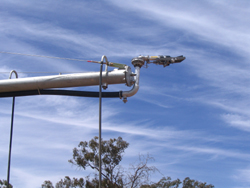4.2.1.2 - What shape can be irrigated?
Return to Main Menu | Return to Step 4 | Return to Step 4.2.1 | Next Step
Centre pivot systems irrigate a circle, which covers 78% of a square. This can be an issue on dairy farms with limited land availability. “Nesting” of multiple pivot circles allows for a greater proportion of land to be irrigated but is normally only an option for larger stretches of land under new irrigation development.
A part circle may be desirable to fit the available land. However, this compromises the management of the pivot. The pivot has to irrigate in reverse over the recently irrigated ground to its initial starting location (as with a lateral move), with the potential for wheel rutting or even “bogging”. With a 360o full-circle pivot, the driest ground is immediately ahead of the pivot. However, a part circle can be managed and is an option that can be considered.
| End-guns can irrigate part of “cut-off” corners that can’t be reached by standard pivots. However, they are not generally recommended because of poor irrigation uniformity in the end-gun irrigated area, and the pressure required to run them. However, they may be attractive to maximise the area irrigated. For more information see Step 4.2.2.3. Lateral moves irrigate rectangular areas– see Step 4.2.2.8. A variation of a side-feed lateral move (with the water supply and pump at one end of the lateral) allows the lateral to operate as a pivot around the supply point at the end of its travel, so irrigating an oval shape. This involves an additional complexity over the normal lateral move or pivot. Corner system – This is a hinged lateral at the end of the pivot that can irrigate corners. They add substantially to the complexity and cost of a pivot and are rarely used in Australia. |  End gun |


